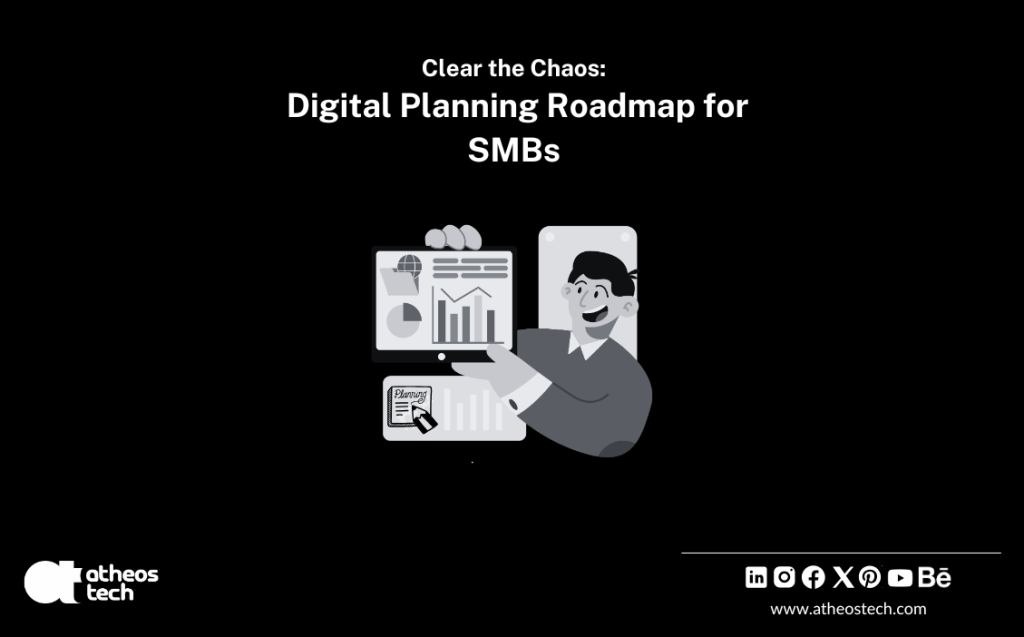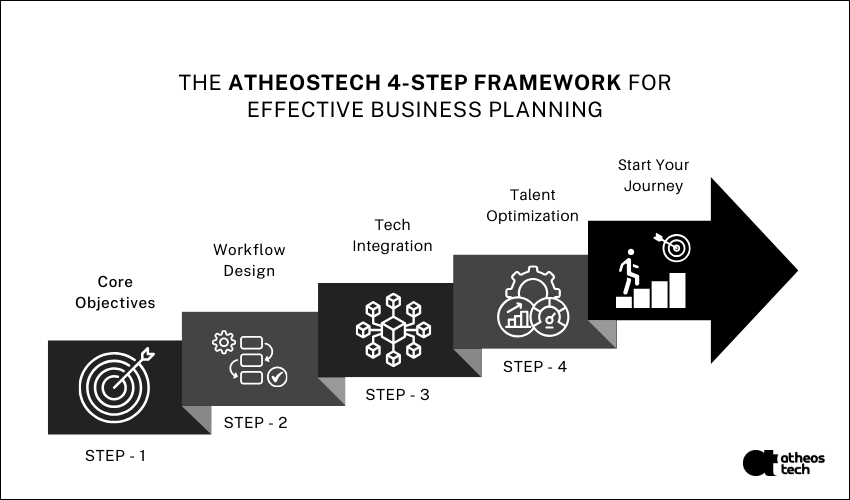
Hire UI UX Designer to Transform Your Brand Across Every Digital Channel

We do not believe in luck. We do not engage in speculation. The services offered by our growth marketing consultancy are built upon a foundation of absolute certainty. We don’t guess; we know. And what we know is how to make you win.
Your browser is screaming. Why? Count the open tabs.
One for your CRM. Another for your accounting tool. Three spreadsheets fighting for your attention. A project management tool that half the team doesn’t use. And Slack pinging in the background like an over-caffeinated intern.
Congratulations. You’re digitally active. But strategically? You’re lost in the sauce. You’ve invested in small business IT solutions, sure – but without a strategic framework, even the best tools turn into clutter.
Your software is digital. Your process is pure chaos.
In our foundational guide, Digital Transformation for SMBs: Risk Falling Behind or Adapt Now with Small Business IT Solutions, we embraced that buying tools ≠ transformation. Most SMBs didn’t transform – they just subscribed. Signed up for tech. Never set up a strategy. And now they’re running fast… in circles.
Then in our second blog, The 3 Digital Phases: Management, Planning, and Automation for SMBs, we broke down the only transformation path that actually works – from chaotic management, to strategic planning, to scalable automation. Miss a phase, and your “automation” just becomes chaos at speed.
This guide is the intervention.
This is not another tech tutorial or a list of ‘Top 5 Apps’ to add to your bloated subscription list. This is a thinking model.
This article gives you the 4-layer digital planning structure we use at AtheosTech – a diagnostic model that’s helped dozens of small business owners move from tech clutter to operational clarity.
If Digital Transformation was the “why”
If The 3 Phases were the “what”
Then this – right here – is your “how”.
Your roadmap begins now.
Chaos isn’t something that happens to your business; it’s the natural state that emerges when you operate without a plan. It’s the default result of good intentions and disconnected actions.
Let’s validate the discomfort:
You’re not alone. This is how most SMBs operate before they get serious about planning.
These aren’t random operational annoyances. They’re symptoms – and the diagnosis is consistent:
You’ve been reacting instead of planning.
What looks like tool confusion is actually goal confusion.
What looks like team resistance is actually system misalignment.
What looks like inefficiency is really a lack of design.
In short: digital chaos = the cost of skipping strategy.
Answer honestly – no one’s watching (except your future P&L).
1. Do you have software subscriptions your team barely uses?
2. Are meetings your primary method of status updates?
3. Do critical workflows rely on one key employee to function?
4. Are departments using siloed tools that don’t integrate?
5. Do major decisions happen via gut feel, not dashboards?
Score Yourself:
Let’s fix that.
The companies that think they’re “too small” to need planning?
They’re the ones who lose the most time, money, and sanity trying to untangle the mess later.
Let’s get one thing straight:
Buying software isn’t a strategy.
Hiring a tech guy isn’t transformation.
And automating chaos is just scaling dysfunction.
Most small business IT solutions promise promise speed. But speed without direction is just chaos at scale.
A Digital Planning Framework is a structured approach that aligns your business goals with your systems, processes, and people.
It’s not another tool. It’s the thinking model behind how you choose, implement, and operationalize the tools you already have; or the ones you actually need.
Think of it like an architectural blueprint.
You wouldn’t build a house by buying random bricks and hoping they align. So why run your business that way?
Post-COVID, post-AI, post-“we’ll figure it out later” – SMBs no longer have the luxury of winging it.
Here’s what’s changed:
And your competitors are evolving – some quietly, some aggressively.
In this climate, lack of structure isn’t just inefficient. It’s dangerous. Chaos is now more expensive than ever. It burns your time, it destroys team morale, and it silently eats away at your profit margins.
Still think planning is optional? Here’s what it’s costing you behind the scenes:
And the kicker? It’s not just money you’re losing. It’s momentum.
Every quarter you delay structured planning is a quarter your competitors use to pull ahead – quietly, efficiently, and at scale.
In our consulting services for small business, we’ve seen clients spending 6 figures annually on tech – and still using email and Excel to run their business.
Structure first. Systems second. Always.
This is the heart of the entire guide. It’s the structured, repeatable system we use to pull businesses out of chaos and set them on a path to scalable growth.
Forget random acts of digital. Forget buying software based on a hunch. This is your new operating manual.
This framework is how we change that.
It’s not a to-do list. It’s your foundation.
A 4-layer stack that turns digital confusion into deliberate progress – and it’s the exact model we use with our clients at AtheosTech.
Think of this like building a smart home.
Would you wire up the automation before pouring the concrete?
The philosophy is simple: we don’t start with technology. We start with the business. You wouldn’t pick out doorknobs before you’ve approved the blueprints for the house. And yet, that’s how most SMBs approach their technology.
The Framework Isn’t Linear – It’s Layered.

Start with the why. What does success look like in the next 12–18 months?
Your goals define your tech – not the other way around.
If your team can’t answer, “What are we solving for?”, then every software decision is just a gamble with your budget.
Now let’s move to the how. What are the processes driving those outcomes?
This is where most “automation” fails – because you’re automating broken processes.
Don’t digitize dysfunction. Redesign first.
This is where tech finally enters the chat. But with purpose.
Tech should serve the process. Not dictate it.
Most SMBs discover they’re paying for two tools to do one job – and neither is doing it well.
Finally, the human layer – the one that makes or breaks everything above.
You don’t have a digital strategy if no one owns it.
The biggest ROI doesn’t come from software; it comes from people using it with intent.
| Layer | Action Step | Purpose |
|---|---|---|
| Business Priorities | Step 2: Define Business Goals | Set the direction |
| Process Mapping | Step 1: The Brutally Honest Audit | Expose the inefficiencies |
| System Mapping | Step 3: Prioritize with Impact/Effort Matrix | Decide what to fix, and when |
| Team Enablement | Step 4: Build a 12-Month Roadmap | Drive adoption and accountability |
Most SMBs try to automate without auditing.
They implement systems without clear goals.
They train teams after the tech fails.
This framework fixes that. It stacks structure under systems. Strategy under software. People above platforms.
Let’s bring this home with a real-world story (names changed, chaos not).
Meet “Wayne Labs”
A fast-growing, 25-person SaaS consultancy with a global client base, a strong pipeline… and a digital mess that was quietly killing their scale.
Cut the Chaos
Build Your Digital Roadmap Today
They weren’t failing because of a lack of tools.
They were failing because of no cohesive plan.
1. Layer 1: Business Priorities
They stopped chasing “efficiency” for its own sake and got real:
Their top goals were profitability and client retention. That changed everything.
2. Layer 2: Process Mapping
They focused on one broken process: lead to onboarding.
They mapped the actual flow, identified 5 manual choke points, and built a unified process for sales and operations.
3. Layer 3: System Mapping
They realized their CRM could do what three tools were clumsily doing – they just weren’t using it right.
Two tools were retired. Integration priorities became clear.
4. Layer 4: Team Enablement
A single operations lead was assigned CRM ownership.
The sales team was retrained – not just on how to use it, but why it mattered.

“We thought planning would slow us down. Turns out, it was the only way to scale without breaking things.”
– Wayne Labs Founder
Planning didn’t delay their growth – it unlocked it.
The framework didn’t add overhead – it removed waste, confusion, and chaos.
Because they’re not trying to. That’s not their business model. Ours is.
Let’s have a grown-up moment here.
Tech vendors sell tools. Not transformation.
They’re incentivized to show you features, not fit.
They’ll happily demo dashboards, not diagnose dysfunction.
And they certainly won’t tell you:
“Actually, you don’t need our software right now – you need a strategy first.”
Most small business consulting firms focus focus on operations or marketing in silos. At AtheosTech, we diagnose your entire digital ecosystem.
We’ve consulted dozens of SMBs across industries, and here’s what usually happens when tech decisions aren’t driven by planning:
It’s not the tech that fails.
It’s the lack of a strategic context.
At AtheosTech, we don’t start by selling you something.
We start by asking questions – brutally honest ones – because your business deserves more than another subscription.
| What Vendors Do | What a Strategic Small Business Consulting Firm Does |
|---|---|
| Sell based on features | Align tools with business outcomes |
| Focus on their product | Audit your entire ecosystem |
| Work with one department | Align tech across teams and processes |
| Push “quick wins” | Prioritize what drives real transformation |
| Provide support tickets | Offer strategic accountability |
Just because you’re using digital tools doesn’t mean you’re digitally transformed.
You may be paying for a premium stack, but running a chaotic system.
The harsh truth?
Tool adoption ≠ strategy.
Software ≠ system.
Implementation ≠ integration.
Don’t buy more disconnected small business IT solutions. Build a plan first..
Then, and only then, should you plug in the right tools – with intention, ownership, and ROI baked in.
Fix the Process Before the Platform
Let’s not sugarcoat it.
You can’t scale what you haven’t structured.
You can’t delegate chaos. You can only multiply it.
And in today’s digital economy, chaos isn’t just annoying – it’s expensive.
If your business feels like it’s stuck in reaction mode – chasing fires, buying tools, duct-taping processes together – that’s not just inefficiency.
That’s a lost margin. Lost morale. Lost momentum.
This isn’t a phase where you can “wait out.”
The digital future isn’t slowing down. The cost of confusion is only going up.
And guess what? Your competitors are figuring it out while you’re figuring out where that invoice went.
This framework isn’t about doing more tech.
It’s about making better decisions – consistently, across your entire business.
Clarity isn’t an upgrade. It’s the foundation.
And you either build it… or keep building around the cracks.
As a small business consulting company, we don’t sell software – we design digital clarity. We hold your hands from ‘Chaos to Clarity’
Ready to go from guessing to growing?
If you’re drowning in disconnected small business IT solutions, it’s time to structure. Let’s build your digital roadmap.
Book a Strategic Planning Call – 30 minutes.
Adding {{itemName}} to cart
Added {{itemName}} to cart